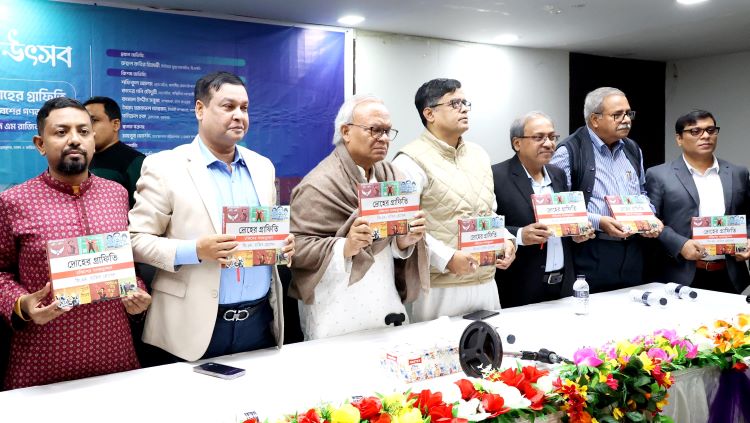News Flash
News Flash

DHAKA, Feb 08, 2025 (BSS) – A new book compiling the graffiti and artworks of July Mass Uprising authored by journalist GM Rajib Hossain was launched today at the Jatiya Press Club, coinciding with the ongoing Amar Ekushey Book Fair 2025.
The 144-page “Droher Graffiti: Chobisher Gono Obhyutthan” contained the images of 161 selected graffiti and artworks on walls in capital and other major cities and a brief background of each as captions.
BNP Senior Joint Secretary General Ruhul Kabir Rizvi launched the book as the chief guest at the ceremony joined by Chief Adviser Professor Muhammad Yunus’s Press Secretary Shafiqul Alam as the special guest.
Writer Rajib, a deputy chief news editor of Bangladesh Sangbad Sangstha (BSS), dedicated the book to the Uprising martyrs and wounded ones.
He described the background the graffiti campaign to boost the July-August 2024 Uprising against the autocracy amid brutal and ruthless obstructions by police and cohorts of the then Awami League regime.
“The wall graffiti and writings will be erased in the course of time and therefore the objective of the book is to keep a record of the time of the uprising,” Rajib wrote.
The book contained two prefaces by Dhaka University professor of mass communication and journalism and interim government’s Media Reform Commission member Dr Gitiara Nasreen and poet and writer Mahbub Morshed, who is also the BSS Managing Director and Chief Editor.
BSS photo journalist Yeahia Shamim took the photographs of the graffiti compiled in the book.
Rizvi appreciated the publication and underscored the need for preserving the history of the July uprising through books, poems, movies and other creative works.
He said artworks and graffiti played a pivotal role in the July uprising as cultural involvement is essential for any revolution or uprising.
The BNP leader questioned the role of the country’s leading cultural figures, poets, writers and litterateurs in favour of Hasina and recalled many legendary poets and writers favored Hitler and Mussolini during their Nazi and Fascist regimes.
“In the same way, some academics, cultural figures and intellectuals supported Sheikh Hasina’s fascist rule and created narratives in her favour,” he said.
Shafiqul Alam underscored the need for maintaining proper documentation on the July uprising through preserving graffiti and artworks of the movement.
“Now it is our job to present the brutality of 15 years through research. We will hold seminars in every campus. We will write against the injustice on every wall so the dictator and its allies cannot return. We have to do this,” he said.
Those who think the July uprising was just a campaign of 21 days are wrong since the uprising had a background of 15 years of struggle.
“We have to fight for another 15 years. If we stop for a while, they will try to raise their heads again. We cannot let it happen,” Alam said.
He said as many as 30,000 people were killed in the hands of the Rokkhi Bahini during Sheikh Mujibur Rahman’s rule and added the ousted regime in the past 15 years made an attempt to erase the history and impose a new history.
“The main tool of exploitation is to forget history. Now the oppressors claim them as victim of oppression,” Alam said.
In his welcome address, poet and writer Mahbub Morshed laid emphasis on preserving the artworks and graffiti of the mass-uprising to allow the next generation to know the true history of the movement.
Morshed cited from Czech-French novelist Milan Kundera’s ‘The Book of Laughter and Forgetting,’ where the writer said - “The struggle of man against power is the struggle of memory against forgetting”.
“Authoritarian rulers always want to establish their own fabricated narratives denying all counter narratives,” the BSS chief editor said.
He said the conservation of artworks and graffiti was crucially needed to keep alive the uprising’s spirit forever and strongly establish a narrative which cannot be countered by any means in future.
Bangladesh Federal Union of Journalists (BFUJ) Secretary General Kader Gani Chowdhury said graffiti played an unprecedented role to inspire the entire nation during the anti discrimination student movement followed by massive popular uprising in July-August.
There were two aspects of July graffiti, one was raising voice against autocracy with slogans like ‘Soirachar Nipat Jak’ (down with fascism) and other one was a call for building a humanitarian Bangladesh.
“What did we learn from the graffiti? We learned that the July graffiti was stronger than canon. The graffiti were weapons against bullets in the movement,” said Chowdhury, also the Secretary General of Sammilita Peshajibi Parishad.
JPC President Hasan Hafiz, Bangla daily Amar Desh Executive Editor Syed Abdal Ahmed, journalist Kazi Rawnak Hossain and Deputy Secretary and 25th BCS (All Cadre) Forum President Nurul Karim Bhuiyan also spoke on the occasion.
Junan Nashit, deputy chief news editor of BSS, conducted the event.